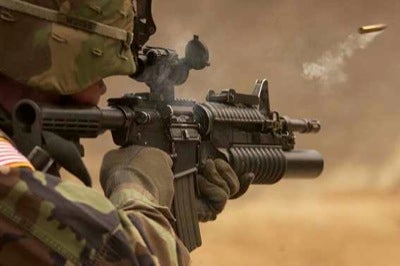Yesterday I blogged about the M4 reliability controversy story that was originally reported by the Associated Press. At best the writer of the AP article exaggerated many the points. The leaked draft of the of the analysis of the Battle of Wanat reads quite differently.
The AP infers that the barrels of many of the weapons were getting white hot. From the AP article:
The platoon-sized unit of U.S. soldiers and about two dozen Afghan troops was shooting back with such intensity the barrels on their weapons turned white hot.
There is only one reference to a gun getting white hot in the draft report, and it is a SAW not a M4 Carbine:
Specialist Bogar fired approximately six hundred rounds at a cyclic rate of fire from his SAW when that weapon became overheated, and eventually jammed the bolt forward. Specialist Stafford noted, “Bogar was still in our hole firing quite a bit. Then Bogar’s SAW jammed. Basically it just got way overheated, because he opened the feed tray cover and I remember him trying to get it open and it just looked like the bolt had welded itself inside the chamber. His barrel was just white hot.”
In fact, it is not even possible that an M4 barrel can heat up to the point of being white hot. M4 barrels are made from Alloy Steel 4150. The melting point of this steel is 1426 degrees Celsius. For steel to go white, it needs to be over 1400 degrees Celsius.
The Ground Precautionary Message ACALA #97-031, from November 1996, clearly states that if an M4 barrel reaches just 737 degrees Celcius, the barrel will be weaked to the point where burst.
(3) BURST BARRELS RESULT WHEN THE WEAPONS ARE FIRED UNDER VERY EXTREME FIRING SCHEDULES AND THE BARREL TEMPERATURE EXCEEDS 1360 DEGREES FAHRENHEIT. WHEN THE BARREL REACHES THESE EXTREME TEMPERATURES, THE BARREL STEEL WEAKENS TO THE POINT THAT THE HIGH PRESSURE GASES BURST THROUGH THE SIDE OF THE BARREL APPROXIMATELY 4 INCHES IN FRONT OF THE CHAMBER. THIS CONDITION CAN RESULT IN SERIOUS INJURY.
You are not going to see an M4 barrel white hot because by that point it would have exploded!
The AP also infers that the M4 Carbine is designed to handle a high rate of fire
The high rate of fire appears to have put a number of weapons out of commission, even though the guns are tested and built to operate in extreme conditions.
This is also not true. From the Ground Precautionary Message[^1]:
(B) FIRING 140 ROUNDS, RAPIDLY AND CONTINUOUSLY, WILL RAISE THE TEMPERATURE OF THE BARREL TO THE COOK-OFF POINT. AT THIS TEMPERATURE, ANY LIVE ROUND REMAINING IN THE CHAMBER FOR ANY REASON MAY COOK-OFF (DETONATE) IN AS SHORT A PERIOD AS 10 SECONDS.
…
(D) SUSTAINED RATE OF FIRE FOR THE M16 SERIES RIFLES AND M4 SERIES CARBINES IS 12-15 ROUNDS PER MINUTE. THIS IS THE ACTUAL RATE OF FIRE THAT A WEAPON CAN CONTINUE TO BE FIRED FOR AN Indefinite LENGTH OF TIME WITHOUT SERIOUS OVERHEATING.
No operator should empty more than 4 magazines rapidly. The AP quotes the draft report:
My weapon was overheating. I had shot about 12 magazines by this point already and it had only been about a half hour or so into the fight. I couldn’t charge my weapon and put another round in because it was too hot, so I got mad and threw my weapon down.”
I sympathize with the solider and would not dare to presume to question his actions in combat. He did what he had to do in the heat of the moment, but I cannot think of any current weapon in the M4 class that can sustain continuous fire. To make such a weapon it would need to have a heavy quick change barrel and maybe also include a heat sink. I doubt any soldiers will want to trade in their M4 for a heavy automatic rifle.
Many thanks to Jay, aka. jdun1911, for his research into this controversy. He should get all the credit for this blog post.
UPDATE: I just want to clarify a point mentioned by commenters below. If the solider fired his 12 magazines evenly over a 30 minute period he should have had no overheating problems (assuming the Army GPM info is correct). What we do not know is the period of continuous fire. As Bram, who has seen combat, said “Time moves very differently while under fire. It’s impossible to judge how fast those soldiers were actually firing.”.
-
I do not make a .mil link to the GPM but it is widely published on the internet. It can be read in full on The Firearm Blog. I did verify, on a .mil website, that this GPM does exist. ↩
 Your Privacy Choices
Your Privacy Choices

